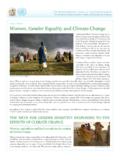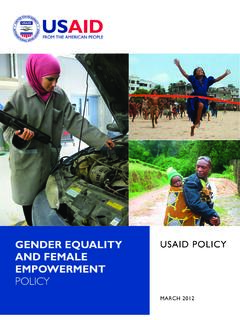Transcription of Working wives and mothers: what happens to family life?
1 Working wives and mothers: what happens to family life? The changing work role of women has caused much concern about the survival of the family ; most women can mix work with marriage and motherhood and handle or better share the resulting household responsibilities SAR A. LEVITAN AND RICHARD S. BELOUS American families seem to be besieged from all sides. Divorce rates are climbing; marriage is being post-poned, if not rejected; fertility rates are falling; increas-ing numbers of children are being raised only by their mothers, either because of divorce or because their par-ents were never married; and wives and mothers in re-cord numbers are rushing out of the home into the labor market. what is the effect of these occurrences on the institution of the family ?
2 Does the "economic inde-pendence" of Working women influence their decisions to either begin or end a marriage or to rear children? Too frequently, the changing work patterns of women are confused with causing the deterioration of family life. Careful analysis of family -related data show that al-though American families are changing, they are not eroding. The fact that women are Working in record numbers is not a new phenomenon. what has changed are the conditions and places in which they work. Many tasks which were once performed inside the home are now the source of jobs held by women outside the home. World War II stands as a major breaking point in fe- Sar A. Levitan is director of the Center for Social Policy Studies, George Washington University, and Richard S.
3 Belous is executive di-rector of the National Council on Employment Policy. This article is adapted from their book, what 's Happening to the American family ?, to be published by The Johns Hopkins University. Press, Fall 1981. male work patterns. The war effort's high demand for labor and patriotic fervor induced many women to join the labor force , boosting the size of the female work force by 57 percent during the war. Some analysts pre-dicted that after the war family work patterns would re-turn to the previous norm. They reasoned that rising productivity and economic growth would continue to boost the income earned by husbands, thus reducing the need for another check and inducing wives to return to their homes.
4 This, of course, did not happen , as economists failed to consider the nonpecuniary attrac-tions of work and the appetite for more income. Since World War II, American households have shown a strong propensity to increase their consump-tion of goods and services. Many wives joined the work force to finance these upward consumption patterns. Like the mechanical rabbit leading the greyhounds around the racetrack, these aspirations have consistently stayed ahead of rising productivity, often requiring an-other paycheck in the chase for the "good life." With inflationary pressures and slow growth in productivity during the 1970's and early 1980's leading to sluggish gains and even occasional declines in real earnings, an-other check became necessary to maintain the standard of living, or growing consumption expectations, to which the families had become accustomed.
5 By 1980, 3 of 5 families had at least two household members in the labor force -in most cases, the husband and the wife. 26 Work, marriage, and motherhood Some futurologists have assumed that the vast up-surge of women in the work force may portend a rejec-tion of marriage. Many women, according to this hypothesis, would rather work than marry. This "inde-pendence effect" would reduce the probability that women would marry as they are better able to support themselves. The converse of this concern is that the prospects of becoming a multi-paycheck household could encourage marriages. Data show that economic downturns tend to postpone marriage because the parties cannot afford to establish a family or are con-cerned about rainy days ahead.
6 As the economy re-bounds and prospects improve for employment, financial security, and advancement, the number of marriages also rises. In the past, only the earnings and financial prospects of the man counted in this part of the marriage decision. Now, however, the earnings abili-ty of a woman can make her more attractive as a mar- riage partner-a dowry. modern version of the old-fashioned Coincident with the increase in women Working out-side the home is the increase in divorce rates. Yet, it may be wrong to jump to any simple cause-and-effect conclusions. The impact of a wife's work on divorce is no less cloudy than its impact on marriage decisions. The realization that she can be a good provider may in-crease the chances that a Working wife will choose di-vorce over an unsatisfactory marriage.
7 But the reverse is equally plausible. Tensions grounded in financial prob-lems often play a key role in ending a marriage. Given high unemployment, inflationary problems, and slow growth in real earnings, a Working wife can increase household income and relieve some of these pressing financial burdens. By raising a family 's standard of liv-ing, a Working wife may bolster her family 's financial and emotional stability. Psychological factors also should be considered. For example, a wife blocked from a career outside the home may feel caged or shackled to the house-a situation some have dramatically likened to a pressure cooker with no safety valve to release the steam. She may view her only choice as seeking a divorce.
8 On the other hand, if she can find fulfillment through work outside the home, work and marriage can go together to create a stronger and more stable union. Also, a major part of women's has been due to the fact that, in remained the main breadwinners. capacity and status occupations inequality in marriage most cases, men have With higher earnings outside of the home comes the capacity to wield power within the family . A Working wife may rob a husband of being the master of the house. Depending upon how the couple reacts to these new conditions, it could create a stronger equal partnership or it could create new insecurities. Given these conflicting and diverse factors that may have bearing on divorce, statistical demonstration show-ing a direct positive relationship between divorce and a wife Working is unattainable.
9 Often studies have reached the conclusion that families in which the wife is work-ing are no more likely to separate or divorce than households in which only the husband is in the labor force . The relationship between the expanding female work force and reduced fertility rates appears to be clearer. With advances in family planning, a majority of wives have managed to combine motherhood with work. The entry of women in the work force has not led to a vast increase in childlessness among married couples, but has led to a lower fertility rate among Working wives when other social and economic factors are taken into consideration. Yet some reservation may be appropriate. In West Germany, for example, fertility rates of the na-tive population during the 1970's have declined even more than in the United States, but with a smaller in-crease in female labor force participation .
10 Coping with family -related duties. The wife's responsibil-ities outside the home have not filtered back into a major reallocation of responsibilities within the family . With the rising costs of household help, the option to pay another person to do the housework is beyond the means of the vast majority. Also, there are limits as to the chores that can be passed on to the friendly neigh-borhood supermarket clerk or appliance seller. Even more than in the office or factory, too many household chores cannot be mechanized. Worksharing by other members of the family remains largely a hope. The Working wife and mother is, therefore, left to her de-vices to cope as wage or salary earner and unpaid houseworker. When the number of hours a Working wife labors outside the home are added to the time spent on house-hold chores, some studies have concluded that most Working wives wind up laboring more hours per week than their husbands.
















